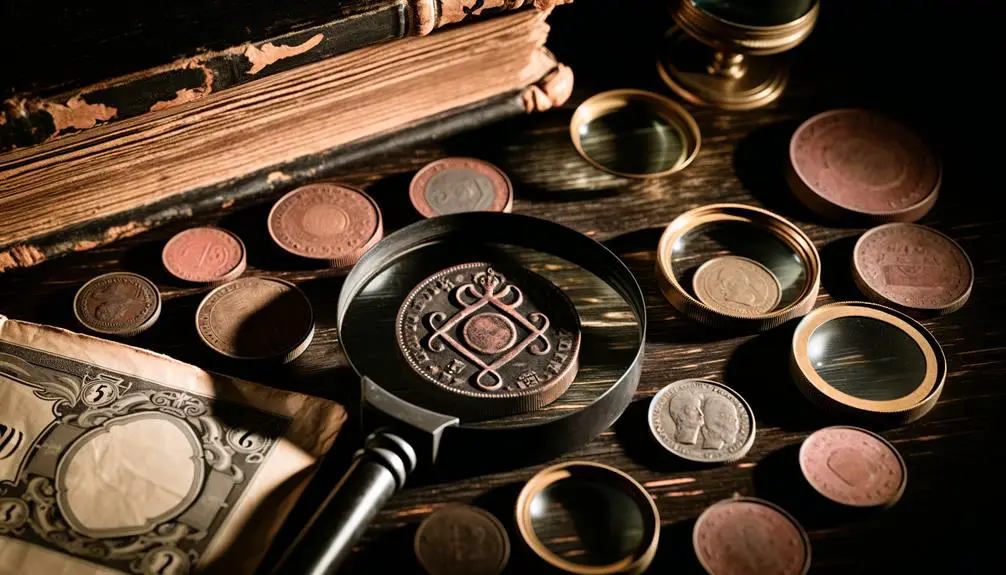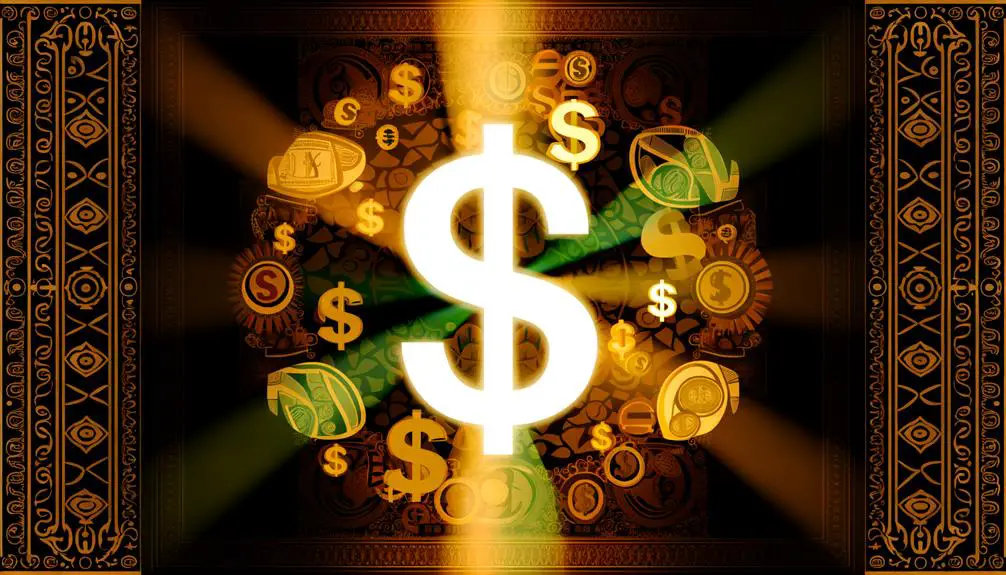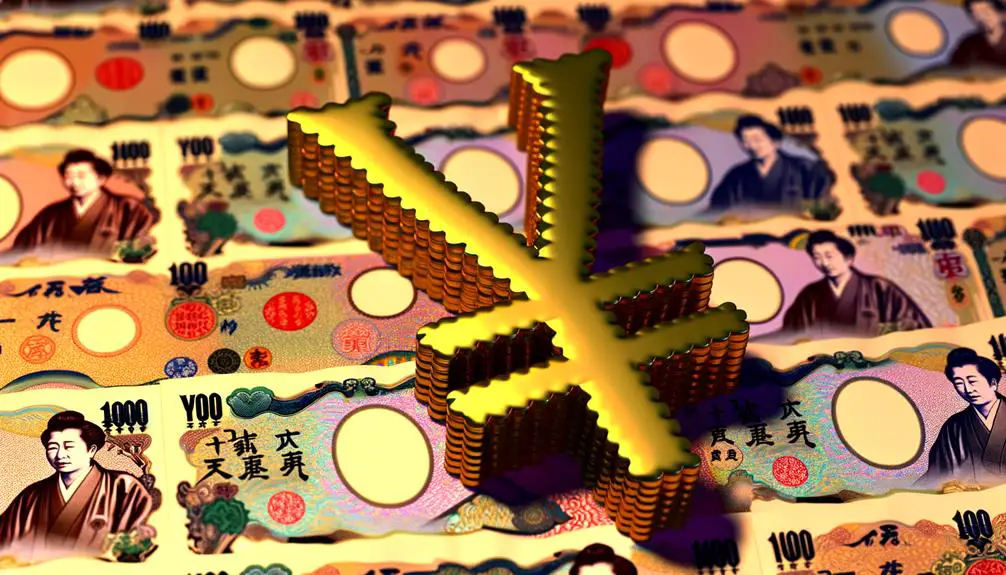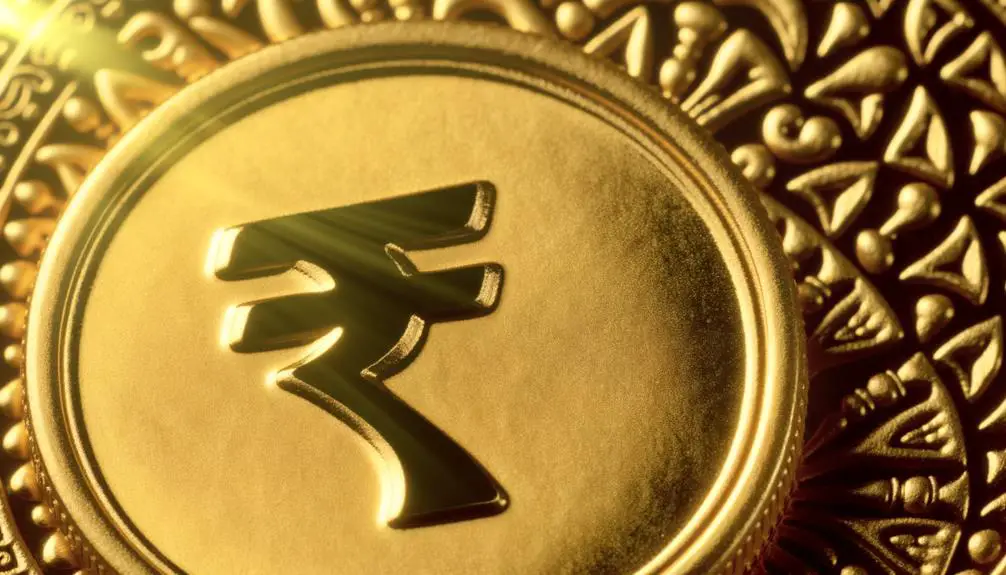What Meaning Does This Currency Symbol Have in Money?
Symbols in money serve as representations of their respective currencies' economic value and historical significance. The dollar sign ($) originated from the Spanish peso and is globally referenced, with the U.S.
dollar holding 59% of global foreign exchange reserves. The Euro (€) is used by over 340 million Europeans, while the Yen (¥) highlights Japan's economic history.
The Pound (£) signifies the British pound sterling's longstanding financial role. The Rupee (₹), designed to blend tradition and modernity, represents India's currency since 2010.
The Franc (₣) symbolizes monetary unity in francophone nations, and Bitcoin (฿) underscores decentralized finance innovation. More intricate details shape each symbol's narrative.

Key Takeaways
- The dollar sign ($) signifies monetary value and originated from the Spanish peso.
- The euro symbol (€) denotes the currency used by 19 EU countries, fostering economic unity.
- The yen symbol (¥) represents Japan's currency and indicates its economic significance.
- The pound sign (£) stands for the British pound sterling, one of the oldest and most traded currencies.
- The rupee symbol (₹) symbolizes India's currency, blending tradition with modernity for global recognition.
The Dollar Sign ($)

The dollar sign ($), universally recognized as a symbol of monetary value, has an intriguing history and significant impact on global financial transactions. Originating in the late 18th century, the symbol likely evolved from the Spanish peso, denoted as 'P^S.' Over time, the 'P' was simplified into an 'S' with two vertical lines, eventually becoming the single-stroke symbol we use today.
The dollar sign's influence extends beyond the United States, as it is used in numerous countries to denote various currencies. In 2022, the U.S. dollar accounted for approximately 59% of global foreign exchange reserves, underscoring its pivotal role in international trade and finance. This ubiquity in financial markets reflects the dollar sign's enduring economic relevance.
The Euro Symbol (€)
Complementing the ubiquity of the dollar sign, the euro symbol (€) has emerged as a significant marker in global finance since its introduction in 1999.
The euro is the official currency of 19 of the 27 European Union member states, known as the Eurozone, and is used by over 340 million Europeans. Its adoption aimed to enhance economic integration and stability within Europe.
The euro symbol, designed to be visually appealing and easily recognizable, encapsulates the cross-cultural unity and economic strength of the Eurozone. Data from the European Central Bank indicates that the euro is the second most traded currency globally, comprising roughly 31.5% of daily foreign exchange transactions, underscoring its critical role in the international monetary system.
The Yen Symbol (¥)

The Yen symbol (¥) holds substantial historical significance, originating during the Meiji Restoration in the late 19th century as Japan sought to modernize its economy.
Today, the Yen is the third most traded currency in the foreign exchange market, underscoring its critical role in global finance.
Analyzing its historical impact and modern usage provides valuable insights into Japan's economic evolution and its current position in international trade.
Yen's Historical Significance
Among global currencies, the yen symbol (¥) holds profound historical significance, reflecting Japan's economic evolution and cultural identity.
Introduced in 1871, the yen aimed to modernize Japan's monetary system, shifting from a complex Edo-era economy of feudal domains to a standardized, centralized currency. Data indicates that the Meiji Restoration played a pivotal role in this transformation, facilitating Japan's rapid industrialization.
By 1897, the yen was pegged to gold, establishing international credibility. Post-World War II, Japan's economic miracle further solidified the yen's global stature. The currency's resilience during economic downturns and its role in global trade underscore its importance.
The ¥ symbol itself, derived from the Chinese character for 'round,' encapsulates both historic and cultural dimensions.
Modern Usage Contexts
In contemporary financial contexts, the yen symbol (¥) frequently appears in international trade, foreign exchange markets, and global financial reports, reflecting Japan's significant economic influence.
As the third most traded currency in the foreign exchange market, the yen accounts for approximately 16.8% of daily forex transactions. Its role in carry trades, where traders borrow yen at low interest rates to invest in higher-yielding assets, underscores its pivotal position.
Additionally, multinational corporations and investors rely on the yen for hedging and diversification purposes. Importantly, Japan's status as one of the world's largest exporters further cements the yen's prominence in global commerce.
The ¥ symbol therefore serves as a key indicator in evaluating economic trends and making informed financial decisions.
The Pound Sign (£)
Recognized globally, the pound sign (£) represents the official currency of the United Kingdom, known as the British pound sterling. The symbol derives from the Latin word 'libra,' indicating weight or balance, tying historically to the pound's weight-based origins.
The British pound sterling, abbreviated as GBP, is one of the world's oldest currencies still in use, dating back to the 8th century. As of 2023, the pound sterling is the fourth most traded currency in the foreign exchange market, accounting for approximately 12.8% of daily global transactions, according to the Bank for International Settlements.
The stability and historical significance of the pound sign underscore its pivotal role in both domestic and international financial systems.
The Rupee Symbol (₹)

The rupee symbol (₹), introduced in 2010, represents the official currency of India and signifies the country's economic identity on the global stage. Designed by Udaya Kumar, it blends the Devanagari "र" and the Latin "R" to symbolize both tradition and modernity. The adoption of this symbol marked a pivotal moment in India's economic history, aiming to position the rupee alongside global currencies like the dollar ($), euro (€), and yen (¥).
| Attribute | Description | Significance |
|---|---|---|
| Year Introduced | 2010 | Modernizes India's global image |
| Designer | Udaya Kumar | Emphasizes cultural integration |
| Composition | Devanagari "र" & Latin "R" | Represents tradition and modernity |
| Global Position | Comparable to $, €, ¥ | Enhances international recognition |
This symbol encapsulates India's aspirations and economic stature, fostering a unified financial identity.
The Franc Symbol (₣)
Introduced to represent the currency of several francophone nations, the franc symbol (₣) serves as an emblem of economic unity and historical continuity in regions that use the franc.
Historically, the franc was adopted in countries like France, Belgium, Switzerland, and several African nations. Data indicates the widespread use of the franc linked to the economic policies of the colonial era, promoting a stable monetary system.
For instance, the CFA franc (XOF, XAF) remains in use across 14 African countries, symbolizing both the legacy and the economic interdependence in these regions.
The franc's enduring presence underscores its significant role in facilitating trade and financial stability among member nations, reflecting a shared economic heritage.
The Bitcoin Symbol (฿)

Amid the rise of digital currencies, the Bitcoin symbol (฿) has become an icon of decentralized finance and technological innovation.
Introduced in 2009, Bitcoin's market capitalization has grown exponentially, reaching over $1 trillion at its peak in 2021.
The symbol itself, resembling the Thai Baht (฿), underscores Bitcoin's global aspirations and digital nature.
Data from blockchain analytics firm Chainalysis shows that Bitcoin transactions accounted for 79% of global cryptocurrency trading volume in 2020.
The symbol's ubiquity in financial news and online platforms signifies its mainstream acceptance.
Additionally, its integration into Unicode (U+20BF) highlights the digital currency's growing legitimacy.
As Bitcoin continues to evolve, its symbol remains a powerful representation of financial autonomy and innovation.
Conclusion
To sum up, currency symbols such as the Dollar Sign ($), Euro Symbol (€), Yen Symbol (¥), Pound Sign (£), Rupee Symbol (₹), Franc Symbol (₣), and Bitcoin Symbol (฿) serve as potent visual markers in the global financial landscape.
These symbols encapsulate the economic essence of their respective currencies, acting as gateways to vast oceans of financial data and geopolitical influence.
Their imagery transcends mere monetary representation, symbolizing entire economies and influencing international trade, investment, and fiscal policies.





